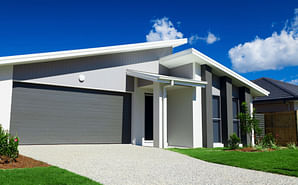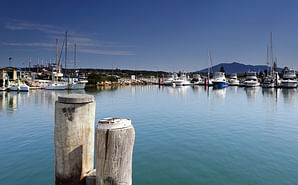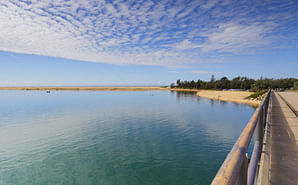Water and Sewerage charges
Service charges for water and sewerage, including access charges.
On this page
Water services - Supply charges
Council collects revenue from the people who benefit from access and use of our water supply - our customers. Customers are charged in two parts - an annual fixed water access charge and a variable water usage charge based on metered use.
| Income source | 2023-24 Estimate |
|---|---|
| Water access charge | $4,750,782 |
| Water usage charge | $8,095,327 |
| Total | $12,846,109 |
Water access charges
The water access base charge (AC20) is for a 20mm connection to our water supply system. This is the standard residential meter size.
| Connection Type | Charge |
|---|---|
| 20mm water connection, strata title (per unit), unconnected properties able to connect (e.g vacant land) | $280 |
| Water access base charge (AC20) | $280 |
Access charges for larger water connections (AC) are based on increments of the base charge according to the following formula: AC = AC x D2/400
- AC = Water access charge - connections larger than 20mm ($)
- AC20 = Water access base charge ($)
- D = Meter size (mm)
The water access charge is shown on the annual rate notice and is independent of water usage.
All approved dual occupancy and secondary dwellings will attract a minimum of 2 water access charges and 2 sewer access charges.
Non-rateable community organisation water access
Following a review of non-rateable properties Council resolved at the November 2022 Council meeting to make an additional water access charge for non-rateable community assessments of $280 to be charged per assessment regardless of meter size.
Water usage charge
The water usage charge for 2023-24 is $3.53 per kilolitre. Water usage is charged four times a year based on actual meter readings.
Allowances
An allowance may apply to home dialysis and home care medical patients. Council requires certification by a medical practitioner and registration with Council for this allowance to apply. Properties with an approved dedicated fire service will have no water access charges applied. If metered water usage occurs outside of emergency use, this exemption will be forfeited.
Sewerage services - supply charges
Council collects revenue from the people who benefit from access to our sewerage infrastructure – our customers.
| Income source | 2023-24 Estimate |
|---|---|
| Sewer access charge | $19,683,307 |
| Sewer usage charge | $1,814,113 |
| Total | $21,497,420 |
Residential sewerage charges
Residential sewerage is charged through a single fixed cost. There is no usage charge.
| Connection Type | Charge |
|---|---|
| Residential sewerage Residential strata and non- strata sewerage | $1,417 |
| Unconnected properties able to connect | $709 |
Non-rateable community organisation sewer access
Following a review of non-rateable properties Council resolved at the November 2022 Council meeting to make an additional sewer access charge for non-rateable community assessments based on a non-residential 20mm connection with a 95% discharge factor to be charged per assessment.
Non-residential sewerage charges
Non-residential customers are charged in two parts. An annual fixed sewerage access charge and a variable sewer usage charge. Sewer use is based on metered water use, and a sewer discharge factor for your property type
Council has adopted this charging structure based on NSW Government advice which can be found in Liquid Trade Waste Management Guidelines 2021, Chapter 8 – Non-residential sewerage and liquid trade waste fees and charges.
Non-residential sewerage access charge
| Connection Type | Charge |
|---|---|
| Non-residential sewerage Non-residential strata and non-strata sewerage | $1,417 |
| Unconnected properties able to connect | $709 |
| Non-residential sewerage access base charge (ACs20 ) | $1,417 |
Sewerage access charges are linked to the size of your water connection. Charges for larger water connections (ACS) are based on increments of the base charge according to the following formula:
AC = AC x20 x D2/400
- ACs = Non-residential sewerage access charge ($)
- ACs20= Non-residential sewerage access base charge ($)
- D = Water supply service connection size (mm)
Non-residential sewerage usage charge
The non-residential sewerage usage charge for 2023-24 is $5.12 per kilolitre.
Sewer discharge factor (SDF)
The sewer discharge factor is a percentage of metered water usage deemed to discharge to sewer. The percentage applied is based on guidance material for different property types provided to us by the NSW Government.
Working out your total non-residential sewerage bill
A non-residential sewerage bill is worked out from this formula:
B= SDF x (ACs + Qw x UC)
- B = Annual non-residential sewerage bill ($)
- SDF = Sewerage discharge factor
- ACs = Non-residential sewerage access charge ($)
- Qw = Your annual water consumption (kL)
- UC = Sewer usage charge ($/kL)
Liquid trade waste - charges
Liquid trade waste (LTW) discharged to the sewerage system from non-residential customers impose additional costs on transport and treatment facilities. To recover these costs and to remove cross-subsidies from residential customers, fees and charges are levied to LTW dischargers. LTW fees and charges are in addition to non-residential sewerage charges and include general fees and charges, category-specific charges and non-compliance charges.
General fees and charges
These are included in our fees and charges document. They include an application fee, annual LTW fee and unplanned inspection and/or re-inspection fee.
Category specific charges
LTW dischargers are divided into four categories for charging purposes. The four categories and calculations used for LTW billing are outlined below.
Category 1: LTW dischargers requiring nil or minimum pre-treatment
LTW1 = A1
- LTW1 = LTW bill for category 1 dischargers
- A1 = Annual LTW fee for category 1
Category 2: LTW dischargers with prescribed pre-treatment
LTW2 = A2 + QLTW x C2
- LTW2 = LTW bill for category 2 dischargers
- A2 = Annual LTW fee for category 2
- QLTW = Total LTW discharge volume (kL)
- C2 = LTW usage charge $2.11 per kilolitre
The LTW discharge volume QLTW is estimated by applying a LTW discharge factor (LTWDF) to the total water consumption. The percentage applied is based on guidance material provided to Council by the NSW Government.
Category 2S: Transporters of human waste
This category includes, as examples, ship-to-shire pumpout facilities, and ‘dump-points’ that are directly connected to sewer.
LTW2s = A2s + Q2s x C2s
- LTW2s = LTW bill for category 2S dischargers
- A2s = Annual LTW fee for category 2s
- Q2s = Total LTW discharge volume (kL)
- C2s = LTW usage charge $19.06 ($/kL)
Dump point owner/operators are only required to pay the annual fee A2s.
Category 3: Large (<20 kL/d) and industrial LTW dischargers
LTW3 = A3 + EMC
- LTW3 = LTW bill for category 3 dischargers
- A3 = Annual LTW fee for category 3
- EMC = Excess mass charges ($)
Excess mass charges (EMC) are for discharges above the ‘deemed concentrations’ in domestic sewage. EMCs are based on NSW Government advice which can be found in Liquid Trade Waste Management Guidelines 2021. The unit charging rates ($/kg) for each substance are obtained from guidance material provided to Council by the NSW Government.
Non-compliance charges
Category 1 dischargers that have not installed or maintained pre-treatment equipment or complied with a notice to install or maintain pre-treatment equipment, may be charged a non-compliance charge using the usage charge formula for category 2 dischargers.
Category 2 dischargers that have not installed or maintained pre-treatment equipment or complied with a notice to install or maintain pre-treatment equipment may be charged a non-compliance charge of nine (9) times the usage charge (C2).
Category 3 discharges that fail to comply with acceptance limits in approval conditions may be charged noncompliance EMC’s using the formulas provided in the Liquid Trade Waste Management Guidelines 2021.
Supply charges - high usage
The high usage charge is a charge that replaces up-front Section 64 water and sewer developer charges. The charge instead incurs a higher rate per kilolitre (kL) for water used and sewage discharged where annual usage exceeds credit volumes established for each non-residential property. One equivalent tenement (ET) credit volume for water is 205 kL/y and for sewer is 190 kL/y.
Existing non-residential properties that are being redeveloped will be assessed for water and sewer ET loads using an assessment of historical water use to establish credit volumes for water and sewer. Previously paid section 64 contributions will be included when establishing credit volumes for the redeveloped property.
Credit volumes for new non-residential developments will be based on section 64 developer contributions paid on the property.
No additional credit volumes will accrue through payment of the high usage charge. Additional credit volumes can be purchased at any time at the section 64 developer contribution rate.
The high usage charge rates are re-calculated annually. A net present value calculation is used where the developer charges for water and sewer which are discounted over 30 years with a rate equal to the IPART Local Government Discount Rate (3.1% in January 2023).
| High usage charges non-residential | Charge |
|---|---|
| Water | $2.47 |
| Sewer | $3.71 |
Mixed Use Development Water and Sewer Charges
Where a property includes both a commercial and residential component, the following charges shall be made:
- Commercial water and sewerage access charges, and
- Separate water and sewerage access charges for each residential occupancy at the same site.
Examples of such premises include a shop with a dwelling at the rear or upstairs, a premise incorporating shop top housing, or a caretaker’s unit in an industrial area.
Supply charges - on-site sewer management
Council charges for the administration of the Shire’s existing On-Site Sewer Management network. Council will continue to charge a single annual amount for all existing On-Site Sewer Management.
Estimated income for On-Site Sewer Management in 2023-24 is $284,920
| Risk Category | Charge |
|---|---|
| Low risk (10 year cycle) | $42.00 |
| Low risk (3 year cycle) | $75.00 |
| Critical risk (1 year cycle) | $168.00 |
Related information






Was this helpful?